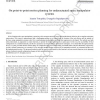Free Online Productivity Tools
i2Speak
i2Symbol
i2OCR
iTex2Img
iWeb2Print
iWeb2Shot
i2Type
iPdf2Split
iPdf2Merge
i2Bopomofo
i2Arabic
i2Style
i2Image
i2PDF
iLatex2Rtf
Sci2ools
RAS
2007
2007
On point-to-point motion planning for underactuated space manipulator systems
In free-floating mode, space manipulator systems have their actuators turned off, and exhibit nonholonomic behavior due to angular momentum conservation. The system is underactuated and a challenging problem is to control both the location of the end effector and the attitude of the base, using manipulator actuators only. Here a path planning methodology satisfying this requirement is developed. The method uses high order polynomials, as arguments in cosine functions, to specify the desired path directly in joint-space. In this way, the accessibility of final configurations is extended drastically, and the free parameters are determined by optimization techniques. It was found that this approach leads always to a path, provided that the desired change in configuration lies between physically permissible limits. Physical limitations, imposed by system’s dynamic parameters, are examined. Lower and upper bounds for base rotation, due to manipulator motions, are estimated and shown ...
| Added | 27 Dec 2010 |
| Updated | 27 Dec 2010 |
| Type | Journal |
| Year | 2007 |
| Where | RAS |
| Authors | Ioannis Tortopidis, Evangelos Papadopoulos |
Comments (0)

